Fundamental Approach
We are proactively working to reduce waste and water intake (water consumption) in cooperation with tenants and building management companies toward realization of recycling society.
For developing and reconstructing buildings, we endeavor to reduce environmental impacts by promoting the 3R (reduce, reuse, and recycle) through the adoption of Longer Life Building designs that enable to reduce waste significantly and use resources effectively.
Resource-saving and Reduction of Waste in Buildings Owned by Hulic and Reconstruction of Buildings
Hulic Group has worked on reduction in the amount of waste disposal and water intake (water consumption) in cooperation with tenants and building management companies. We install toilets that use rainwater and various water conservation systems. Water saving toilets and wash basins are standardized.
Amount of Waste Disposal at Hulic Group
We calculate the amount of waste disposal to reduce waste disposal in order to realize a recycling-oriented society by 2050.
Waste Disposal
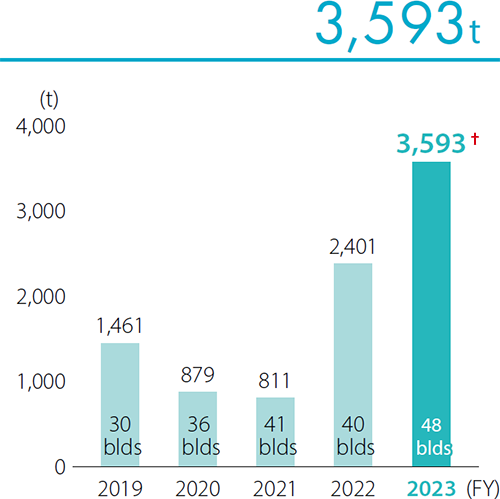
- *Figures marked with “†” have been guaranteed by an independent assurance provider for the values included in our Integrated Report.
Waste they Can and Cannot Be Recycled
(t)
| 2020 | 2021 | 2022 | 2023 | 2024 | ||
|---|---|---|---|---|---|---|
| Number of target | 36 blds | 41 blds | 40 blds | 48 blds | 262 blds | |
| Waste that can be recycled | Paper | 33 | 33 | 475 | 614 | 760 |
| Bottles, cans, plastic bottles | 60 | 54 | 193 | 393 | 369 | |
| Total | 92 | 88 | 668 | 1,007 | 1,130 | |
| Waste that cannot be recycled | Other general waste | 711 | 638 | 1,463 | 2,085 | 2,123 |
| Industrial waste | 76 | 85 | 270 | 501 | 528 | |
| Total | 787 | 723 | 1,733 | 2,586 | 2,651 | |
| Total of waste that can be recycled and waste that cannot be recycled | 879 | 811 | 2,401 | 3,593 | 3,781† | |
- *Figures marked with “†” have been guaranteed by an independent assurance provider for the values included in our Integrated Report.
- *Calculations for waste disposal are based on the properties where the Hulic Group occupies or manages business operations (36 properties in FY2020, 41 properties in FY 2021, 40 properties in FY2022, 48 properties in FY2023, and 262 properties in FY2024). In FY2024, the number of properties increased compared to the previous year due to the implementation of M&A during the period. Beginning in FY2020, we are calculating total waste disposal at specific properties within the boundary by using weight conversion factors based on actual measurements. The waste disposal of certain properties are estimated using the total floor area based on the emissions intensity of buildings with similar functions.
Raw Materials Purchase Volume
| 2020 | 2021 | 2022 | 2023 | 2024 | |
|---|---|---|---|---|---|
| Number of properties | 7 | 9 | 6 | 12 | 7 |
| Steel materials purchase volume (t) | 5,507 | 5,112 | 9,669 | 13,079 | 27,298 |
| Concrete purchase volume (t) | ― | 38,269 | 40,711 | 63,734 | 127,180 |
| Batten cleats purchase volume (m3) | 106 | 261 | 163 | 234 | 284 |
| Plywood purchase volulme (m3) | 204 | 552 | 415 | 508 | 511 |
| Lumber purchase volume (m3) | 335 | 375 | 174 | 230 | 184 |
- *Figures are for developed and constructed buildings for which data were collected in each year.
- *We have started collecting purchase volume data for concrete from 2021.
Promotion of the 3R
Efforts to Reduce
Reduction of plastic waste at head office building
In consideration of the seriousness of marine pollution caused by disposable plastic waste, the in-house canteen at the Hulic head office building has stopped use of disposable plastic beverage containers, straws, spoons and shopping bags. We are also actively encouraging employees to bring their own cups.
Efforts to Reuse
Recycling parts of underground building frames during reconstruction
In reconstruction works, we make various efforts for reducing wastes generated in demolition works including concrete debris. For example, underground building frames of existing buildings are used as retaining walls for the new building with new underground building frames installed inside. We make sure that adequate inspections are conducted to confirm the strength when building frames of existing buildings are recycled.
After considering impacts on neighboring areas of property, we introduced the PC method in some development projects.
Link: Hulic Guidelines for Longer Life Building
Efforts to Recycle
As recycling efforts through daily business activities, we started to recycle used paper and printer toner cartridges. We will continue to work on those efforts to support achieving a recycling society.
Amount of paper recycled*
(Unit: kg)
| Fiscal year | 2020 | 2021 | 2022 | 2023 | 2024 |
|---|---|---|---|---|---|
| Recycled amount | 15,600 | 13,880 | 13,000 | 11,895 | 11,765 |
*The scope is Hulic Head Office Building.
PET Bottle Horizontal Recycling Initiative
(Hulic Hotel Management Co., Ltd. & Suntory Group)
We are implementing “Bottle to Bottle” Horizontal Recycling System program, an initiative to recycle used PET bottles collected at The Gate Hotel Kyoto and The Gate Hotel Ryogoku of our group hotel, into Suntory beverage PET bottles through recycling as resources with technologies such as “Bottle to Bottle”.
Through this initiative, we will contribute to the realization of a recycling-oriented society.
Prevention of Pollution
In order to realize a recycling-oriented society by 2050, we aim to reduce the emission of pollutants. For that, our company considers that the minimization of environmental pollution due to business activities is indispensable to realize a recycling society. When planning buildings, we adopt construction methods to reduce pollutant emissions to the extent possible in cooperation with design and construction companies. In addition, we aggregate data on SOx, NOx, VOC, and hazardous waste generated in the development business to monitor the amounts generated, and we disclose the actual results.
Amount of emission of SOx, NOx and VOC from hazardous wastes
| 2020 | 2021 | 2022 | 2023 | 2024 | |
|---|---|---|---|---|---|
| Number of properties | 7 | 9 | 6 | 12 | 7 |
| SOx emissions (kg) | 142 | 826 | 770 | 2,557 | 1,532 |
| NOx emissions (kg) | 1,649 | 6,778 | 5,132 | 394 | 9,623 |
| VOC emissions (kg) | 0 | 0 | 0 | 84 | 228 |
- * Figures are for developed and constructed buildings for which data were collected in each year.
Initiatives for Water
Initiatives to Reduce Water Intake (Water Consumption)
Almost all water intaken and consumed in the Group are from the buildings owned or the buildings that we have offices, and the water flow starts from tap water and discharge it into sewers. To reduce the amount of water intake (water consumption) in buildings owned by the Company, we have taken the initiative of introducing water-saving devices on water taps installed in the plumbing of existing buildings (saves water by approximately 40% per tap) to preserve water resource.
In addition, to reduce water consumption at all our properties, we have installed water-saving devices in all newly built properties, we are gradually upgrading the toilets in the buildings we own to ensure better plumbing while also changing to water-saving flush toilets and hand washers. The Company is also working to ensure the effective use of water resources by using rainwater to water the greenery and flush toilets for certain buildings. Note that Hulic does not operate business activities in high water stress area where demand for water is tight.
Water Intake (Water Consumption)
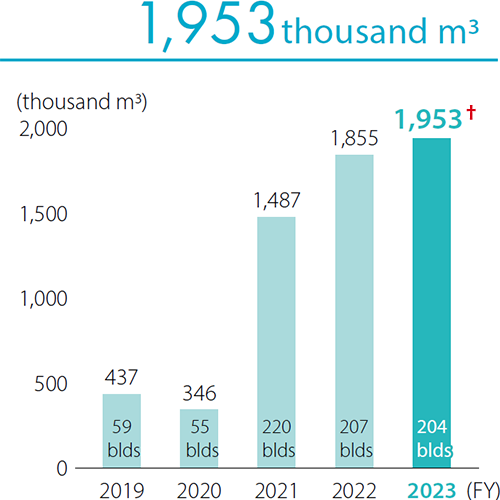
- *Figures marked with “†” have been guaranteed by an independent assurance provider for the values included in our Integrated Report.
- *Beginning in FY2021, Hulic’s fixed assets are covered, excluding properties under development and land for lease (220 properties in FY2021, 207 properties in FY2022, 204 properties in FY2023, and 194 properties in FY2024). Note that the amount of hot spring water used at hot spring ryokans (luxury Japanese inns) is not included. The boundary of FY2020 is properties with a total floor area of 3,000㎡ or more, excluding buildings where bank branch is the sole tenant, as well as sectional and shared ownership properties and real estate for sale.
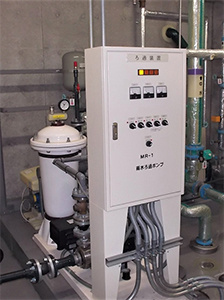
Use of Paper Substitute Materials
From 2022 we began using LIMEX, a paper substitute made primarily from limestone, for the production of this integrated report as well as our business cards. When making LIMEX, which uses almost no forest or water resources, the amount of water used in manufacturing was reduced by approximately 1.43 million liters, compared with the same amount of ordinary paper.
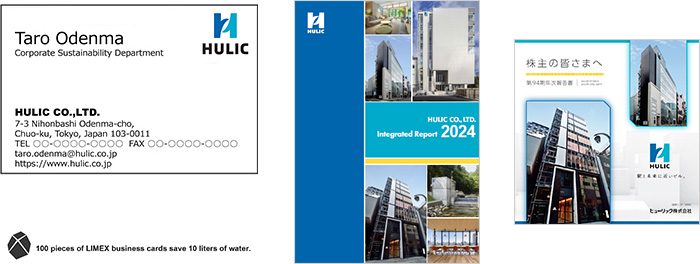
Investment in WOTA Inc.
The Hulic Group regards the efficient use of water resources as an important topic, the Hulic Startup Co. Ltd. has invested in WOTA Co., Ltd., which develops water circulation treatment control systems.
Construction
Adoption of the PC Method
From the standpoint of a business owner, we proactively adopt the PC method*, which can significantly reduce the amount of waste generated during construction. This method, which can shorten a construction period and minimize impacts on surrounding environments during construction, is highly rated in terms of longer life service of buildings.
- *PC (Precast Concrete) method: Precast panels produced at a plant under consistent quality control are carried to a worksite and assembled.
Effect of the PC Method
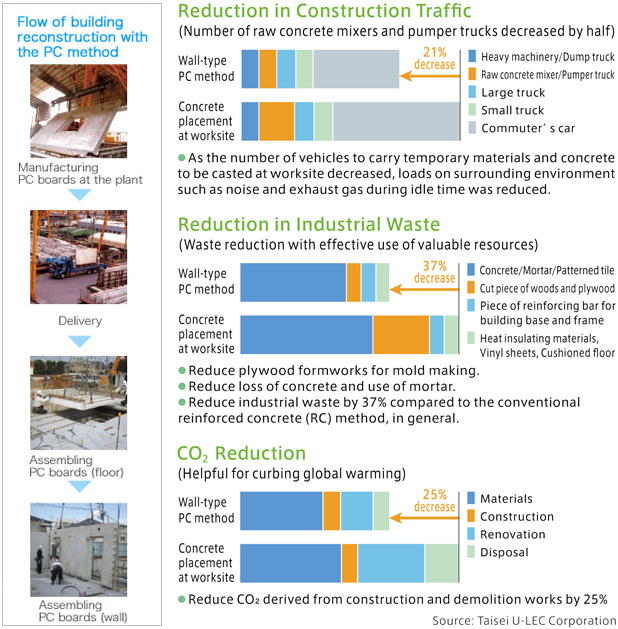
Benefits of Hybrid Fireproof Wooden Construction*
(Reducing environmental burdens)
- Reduced-weight materials
- Rationalization of vehicles and heavy machinery in transportation and construction operations
- Reduction of GHG emissions from transportation - Factory production reduces the amount of onsite work and eliminates onsite waste materials
- Adoption of floor CLT eliminates need for scaffolding
(Benefits within construction activities)
- Highly accurate pre-cut processing (machining) contributes to smooth assembly work
- Convenience when fixing to other building materials with screws
- Since structure is finished material, interior finishing costs are reduced
- *Hybrid structure combining wooden and steel framework
Link:Example of Use 1: HULIC &New GINZA 8 (fireproof commercial building)
